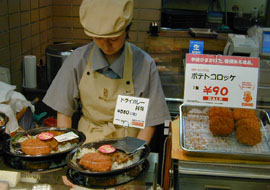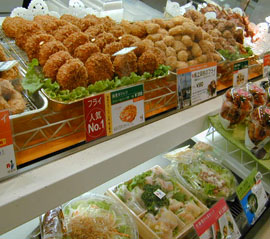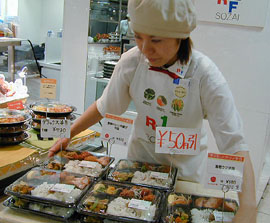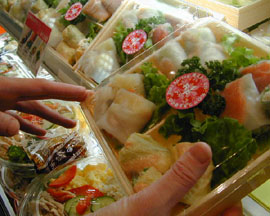Sozai: Japan's Fashionable Food Boom
I fell backwards, tumbling down the staircase, arms flailing just like the investigator in Psycho. At the bottom, I sat in a heap until I heard a voice sigh from above: "Drunk again."
 It was junior reporter Junko. I looked up at her while she cracked open the door to the newsroom near the garbage cans.
It was junior reporter Junko. I looked up at her while she cracked open the door to the newsroom near the garbage cans.
"Hungover is more accurate," I corrected. "I don't see how requiring us to take out our own garbage is saving the newsroom any money."
"Cutbacks of even the smallest sort are being implemented across the board in this recession. So how did your present state come to be?"
"After holding open the trashcan lid for senior secretary Sachiko to dispose of her salad container and waiting a generous amount of time for her to saunter back into the newsroom, I then looked down inside the can and saw what can only be described as heresy on the plastic cover: a price tag of 1,000 yen!"
I took a deep breath and continued, "A quick mental computation revealed it to be the equivalent of 4 large cans of beer. In shock, I took one step back and..."
"We young working women, living at home with our parents, have endless amounts of cash to spend on nice lunches, clothes, etc. As you know, this is not the case for you salarymen."
I looked at my empty Yoshinoya gyudon cup lying on its side to my right.
"You have grease on your shirt collar," she added.
I rubbed my chin with my right thumb and forefinger.
At each of the many outlets of McDonald's and Yoshinoya in the proximity of Tokyo's Shinjuku Station, cut-throat competition in a weak economy has led to falling prices on burgers and gyudon in the continuing search for customers. Suited middle-aged salarymen quickly gobble down burgers at lunchtime before hustling off to a meeting or back to the office. The food is fast, eatable, and cheap.
 However, the lunchtime food scene nearby in the basements of such upscale department stores as Mitsukoshi and Isetan is a photographic negative of that going on above; the foods are freshly prepared salads, pastas, and meats, the customers are mostly young women, and - contrary to economic trends of the day - the prices are through the roof.
However, the lunchtime food scene nearby in the basements of such upscale department stores as Mitsukoshi and Isetan is a photographic negative of that going on above; the foods are freshly prepared salads, pastas, and meats, the customers are mostly young women, and - contrary to economic trends of the day - the prices are through the roof.
Specially prepared food, or sozai, from department stores, cafes, and specialty shops, has over the past few years been experiencing a "boom" in popularity. Fanned by word-of-mouth and the media and fueled by the plentiful cash in the hands of young single women and select well-heeled families, sozai is yet another of Japan's business sectors managing to experience tremendous success while the nation muddles along in recession. The food is being sold in the name of convenience and health, and people are buying it.
At Shinjuku's Isetan on a weekday evening, a dozen uniformed clerks in chef's hats behind glass counters dole out dozens of various salad dishes into small plastic cups. Each cup is weighed, capped, and bagged with lightning speed. This is because customers are lining up a few rows deep, waiting to select their favorite eggplant or tomato salad.
Business is brisk all day. But the peak times are at lunchtime and around 6PM, the time when workers leave the office and head home.
Young women are the most predominant customer. Because larger numbers of women in their 20s and 30s have been shunning marriage and living with their parents, many have a large disposable income. Prepared food is one of the things they have been buying.
At Isetan, 31-year old Kaori Fuji is one example. "I am not married so I don't worry about the price," she says. "On the way back from watching a show, I might stop and see what is available."
What she might find is a huge array of seafood, vegetable, and fruit salads. Nearby perhaps will be cooked lamb chops, meat cutlets, and seasoned fish.
 "I usually just get the things I can't make at home," explains fashion designer Yoko Shimakage of sozai's convenience. The 23-year old thinks that collecting all the ingredients to prepare certain dishes, for example a plate of namaharumaki (seafood wrapped spring rolls), is much more time consuming and difficult for a single person than just buying it already prepared.
"I usually just get the things I can't make at home," explains fashion designer Yoko Shimakage of sozai's convenience. The 23-year old thinks that collecting all the ingredients to prepare certain dishes, for example a plate of namaharumaki (seafood wrapped spring rolls), is much more time consuming and difficult for a single person than just buying it already prepared.
The food floor of Isetan, as with all department stores, is divided into different sections with each section being operated by a different company.
RF1 is one of Japan's leading sozai companies. It specializes in salads. In addition to Isetan, it has operations in Mitsukoshi and Matsuya department stores. Oftentimes, RF1 will have over 24 different salads on offer. Bento (individual lunches of various fish and vegetables) boxes and full party trays are also available. This sort of selection is one of their keys in drawing customers.
Chizura Inoue, a 47-year old housewife says of the selection, "Compared with last year the variety is much larger. It is more colorful and beautiful. A housewife can many get ideas for what she can prepare at home."
Government worker Fumiko Akimoto, 46, agrees and adds, "Shops like RF1 are not what we used to have. Before it was mostly just croquets, curry, or various Chinese food."
This convenience and selection though comes at a high price. Most vegetable salads are generally 300 yen per 100 grams (slightly less than one-quarter pound) while seafood salads are around 500 yen. This is roughly twice that of a typical grocery store. RF1 sells twelve small namaharumaki for 1,000 yen. These relatively high prices (McDonald's sells burgers for less than 100 yen), however, have not slowed sales.
Kyodo reports that sales for RF1 increased 13.5% in the first 6 months of last year. This doesn't amount to small potatoes for the business of the department stores either. Where food sales used to be a means to draw customers into the department store to shop for other things, they now account for approximately 20% of all sales. The Nihon Sozai Association expects sales to increase in fiscal 2001 by more than 5%.
 Nutritional value is seen as another factor in sozai's appeal. RF1's "Veges Energy" campaign claims that many of Japan's societal ills can be improved if more people were to get enough vitamins and minerals in their diet. They argue that healthy foods can lead to a sound mind as well as a sound body. As a means of assistance, many of RF1's products will have a placard detailing calorie, vitamin, mineral, and fiber information. Additionally, should one of their products be from a place famous for that product (for example, Hokkaido is famous for cheese and seafood), the location of its source might be noted on that particular product. This might lead a customer to believe that it is fresh.
Nutritional value is seen as another factor in sozai's appeal. RF1's "Veges Energy" campaign claims that many of Japan's societal ills can be improved if more people were to get enough vitamins and minerals in their diet. They argue that healthy foods can lead to a sound mind as well as a sound body. As a means of assistance, many of RF1's products will have a placard detailing calorie, vitamin, mineral, and fiber information. Additionally, should one of their products be from a place famous for that product (for example, Hokkaido is famous for cheese and seafood), the location of its source might be noted on that particular product. This might lead a customer to believe that it is fresh.
Complicating things is the fact that the business is forever changing. It is vital for sellers to always be on the lookout for the latest trend or hot item. Seasonal items are especially important. One week it might artichoke salads, the next maybe red peppers will be in vogue. Shoppers get the latest tips from the TV news and fashion magazines.
"Women's magazines like Ginza and Spur tell of the latest fashionable and seasonal sozai available in cafes and markets in such places as [Tokyo's] Aoyama and Omote Sando," says Yoko.
Chizura goes so far as to say that the ability of the shops to churn out new products is becoming like a form of art: "Even if I don't buy something, just watching the various dishes appear each day makes me happy."
Note: Nobuko Chuma contributed to this report.

